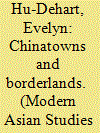|
|
|
Sort Order |
|
|
|
Items / Page
|
|
|
|
|
|
|
| Srl | Item |
| 1 |
ID:
112143


|
|
|
|
|
| Publication |
2012.
|
| Summary/Abstract |
This paper explores two dynamic places and spaces in the Americas, destination of several Asian diasporas-the Chinese, Japanese, and South Asian-as contact and exchange zones. One would be the ethnic enclaves commonly called 'Chinatowns', which stretch over time from the early sixteenth century to the present, and over space from Manila in the Spanish empire across the Pacific to all over the Americas. These Chinatowns, imagined and real and riddled with stereotypes, are well-known tropes on the American landscapes, and need no further preliminary introduction; they are also firmly located within fixed national (or colonial) entities.
The second space has not been historically associated with Asian diasporas in the Americas, although well known for different reasons. Here I refer to 'borderlands', the overlapping space between, over, and above two political national boundaries or borders, in particular the US-Mexican and US-Canadian borderlands, both, coincidentally, clearly marked and delineated by the mid-nineteenth century (1848 and 1846 respectively). Furthermore, as these two transnational/transborder regions are also trans-Pacific, their recognition as an integral part of Asian diasporas is belated and overdue. To make the case further, the study of Asians in the Americas has revealed that Asian migrants, labour, and capital have been historically drawn to these borderlands because they represent dynamic zones of economic development, first in the heyday of maturing American capitalism at the turn of the twentieth century, and again in the glaring eye of current late-capitalist globalization. In other words, Asians have amassed on both sides of these borders for over 100 years, where they have become adept at multiple border crossings, both trans-Pacific and transnational.
|
|
|
|
|
|
|
|
|
|
|
|
|
|
|
|
|
|
|
|
|